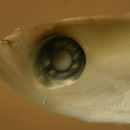en
names in breadcrumbs


Analogues: Compared to other long thin goby larvae, Awaous and Sicydium larvae have shorter dorsal and anal fins and many more procurrent caudal-fin rays. The gobioid sleeper family, the eleotrids, share these two attributes, but have clearly-divided pelvic fins and lack the large internal melanophore over the rear end of the anal fin. The larvae of Sicydium are quite similar to Awaous banana in form, markings, and median-fin ray counts. The primary meristic difference is higher pectoral fin-ray counts in larval Sicydium (20 or more). Both sets of larvae share the large internal melanophore over the anal fin, but Sicydium larvae have additional melanophores, in particular at the base of the upper caudal fin, deep to the pectoral-fin base, and along the mid-abdominal ventral midline. In addition, the large internal melanophore in larval Sicydium has characteristic, sometimes extreme, long filamentous extensions.
Description: Body thin, long, and narrow with a medium-sized round eye and a terminal small mouth. Pectoral fins very short, pelvic fins very short. Dorsal and anal-fin bases short and caudal peduncle sharply narrowing, 10-14 procurrent caudal-fin rays. Melanophores on the head only along the dorsal edge of the anterior premaxilla on each side and midline near the tip of the lower jaw. Ventral melanophores are limited to a paired large melanophore at the mid-base of the anal fin and internal melanophores overlying the posterior swim bladder and extending down to the vent. A large deep internal vertical melanophore underlies the last anal-fin ray extending up to the lateral midline.
Diagnosis: Long thin larvae with a modal fin-ray count of D-VI,11 A-11 Pect-16 indicates the river goby Awaous banana. Coryphopterus personatus shares the fin-ray counts but their larvae are very different; they are smaller and shorter and have typical ventral midline melanophore rows and no large internal melanophores. A. flavus from Colombia to Brazil has a modal fin-ray count of D-VI,10 A-10 Pect-16.
Awaous banana, the river goby, is a species of goby native to fresh and brackish water stream and rivers from the southern United States through Central America to Venezuela and Peru. This species can reach a length of 30 centimetres (12 in) SL. It is important to local commercial fisheries.[1]
Awaous banana, the river goby, is a species of goby native to fresh and brackish water stream and rivers from the southern United States through Central America to Venezuela and Peru. This species can reach a length of 30 centimetres (12 in) SL. It is important to local commercial fisheries.